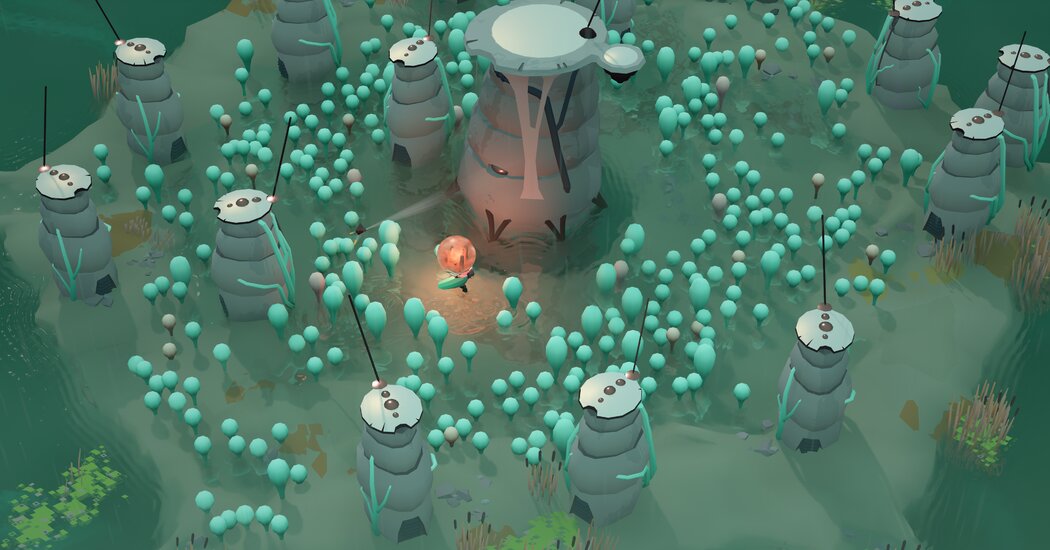Long before the emergence of a winged protagonist who transports powerful orbs across the mysterious landscape of Cocoon, the adventure video game was an abstract computer science exercise gestating in its creator’s head.
Early brainstorming focused on how the spatial relationships between interconnected realms could be used in puzzles, said Jeppe Carlsen, a lead designer of Cocoon. Each orb in Cocoon gives its carrier a unique ability — and contains another realm altogether. By jumping into one orb while carrying another, the pathways for possible solutions multiply.
“The whole concept is a little bit mazelike, being sort of trapped inside a structure of worlds within worlds,” Carlsen said.
Carlsen began seriously pondering Cocoon’s internal logic in 2016 after leaving Playdead, the Danish studio behind Limbo and Inside, games in which a quiet boy pushes, pulls, jumps, swings, climbs and swims his way to the solutions of environmental puzzles.
Those games sold millions of copies, and fans of the genre — which rewards contemplation rather than the fast-twitch ability to shoot enemies — have been waiting to see what Carlsen, the brain behind Playdead’s puzzles, could pull off with his first game at a new studio, Geometric Interactive.
Like Limbo and Inside, the story in Cocoon, which releases for all major consoles and the computer on Friday, is told without dialogue; the lone action button lets you set orbs on door-opening sensors or gently pull a creature into a more helpful location.
Playdead’s games, however, were grim black-and-white meditations on death and free will that used bear traps and guard dogs to instill terror. Cocoon has more pleasurable moments of discovery, with its roots in raw logic.
“It’s not born from a specific mood or wanting to tell a specific story,” said Carlsen, who founded Geometric with Jakob Schmid. “It is spawned from something entirely different.”
Independent designers can often take greater conceptual risks than large studios because they do not need to recoup hundreds of millions of dollars spent creating hyper-realistic graphics and lengthy narratives.
Instead, the revelatory moments in Cocoon are fueled by recursion, a principle common in computer programing in which one solution is inherently connected to another; calculating the next number in the Fibonacci sequence requires adding its previous two integers. (On a more pop cultural note, the director Christopher Nolan used layers of dreams to explore the concept in “Inception.”)
Because the dizzying connection between the worlds in Cocoon — which takes about five to seven hours to complete — was conceived early on, Geometric had flexibility in how to visually represent them.
When Schmid first heard Carlsen’s pitch, he imagined a space setting with walls between different planets. The game’s original prototype was a side-scroller, where the action unfolds from left to right like in the original Super Mario Bros., but they quickly discovered that it flattened the sensation of diving into a new world.
The immersive final product melds the mechanical and the organic, featuring insectoid bosses and stubborn plant life in a desolate environment. The sound design developed by Schmid is entirely synthetic. Crafting a frog’s croaks was an early milestone, he said, and other challenges included the crunch of dirt and the patter of rain.
It was liberating to design puzzles in a top-down environment, Carlsen said. The first orb that Carlsen conceived is the first that players encounter; when carrying it, an orange penumbra reveals hidden walkways. At one point, traveling back and forth between worlds allows you to evade an incoming threat.
Not all of his ideas made the final product. A rhythm orb that explored the relationship with the game’s music, for example, created interesting puzzles but also a constant drumbeat. “I didn’t find a way to not make it distracting,” Carlsen said.
At times, people may be tempted to brute-force their way through Cocoon’s tougher scenarios. In games like Patrick’s Parabox and Baba Is You that lean into mathematical and computer science principles, there is a fine line between dazzling and baffling players.
Patrick’s Parabox introduces infinite loops as an anthropomorphic box pushes others around — and inside one another — but its designer, Patrick Traynor, said he intentionally avoided certain brain-melting puzzles.
“There are also many variations where multiple infinity loops can happen simultaneously, and that can get really hard to model in your head as a player, and even for the game to visualize,” Traynor said.
In Baba Is You, players manipulate rule-imprinted tiles (for example, [Flag] [Is] [Win]) to solve puzzles. But play testers convinced its designer, Arvi Teikari, not to make a level based on one enigmatic concept: For complex reasons, the character Baba can technically pass through walls while on a conveyor belt.
“It’s in no way logical or intuitive to anyone playing the game,” Teikari said, “without full understanding of how it’s implemented.”
For Carlsen, that type of magician’s trick — in which players can accomplish tasks without fully grasping the underlying implications — lets him introduce a paradox late in Cocoon that will make players question everything that has come before.
“There is the feeling,” Carlsen said, “of, oh, this should not be possible.”


